| The marine coastal area along the Esplanade at the Kissing Point end
of Rowes Bay (Figure 1) is very shallow, with an area of several
square kilometres being exposed to the air during spring tides.
 |
| Figure1. View of Rowes Bay from
the Esplanade near Kissing Point - high tide |
This intertidal area includes several different marine habitats such
as a mangrove forest (Figure 2), a rocky shoreline (Figures
3a & b), a small muddy estuarine creek (Figure 4), coarser
sandy flats (Figure 5) and several rubbly reefal areas, one of
which includes a tropical sponge garden on the seaward edge (Figure
6).
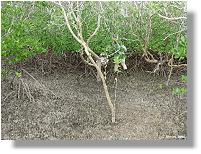 |
 |
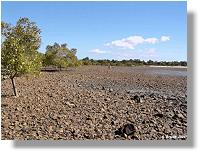 |
| Figure 2. Students exploring the
mangrove forest at Rowes Bay during low tide |
|
Figure 3a Rocky shoreline (Rowes
Bay) at low tide |
 |
 |
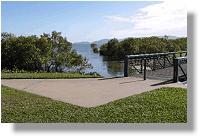 |
| Figure 3b. Rocky shoreline (Kissing
Point) showing JCU students calculating tide levels |
|
Figure 4. Muddy creek area at high
tide |
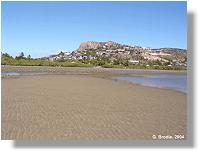 |
 |
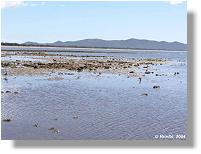 |
| Figure 5. Muddy sandflats exposed
at low tide |
|
Figure 6. Rubbly reefal areas exposed
when the tide is very low |
Collectively these habitats are home to thousands of different types
of marine invertebrates (animals without a backbone) and each individual
habitat contains its own specialised suite of fauna and flora that is
well adapted to the environmental conditions found there.
Some of the invertebrates living on the intertidal area at Rowes Bay
are large and easy to see, whereas many others are smaller and very good
at hiding. Some are motile and able to move from one habitat to another,
while others are sessile and unable to move to a more favourable area
should conditions change or predators threaten. Some species are present
in large numbers while others are more solitary – perhaps even with
their presence changing seasonally.
Although a few local scientists are aware of the high level of invertebrate
diversity in this area, the fauna has never been systematically and collectively
documented and we therefore do not know exactly how many marine invertebrate
species are to be found in this intertidal area.
This website, which is part of the Townsville City Council Natural Assets
Database, aims to begin the huge task of documenting the wide variety
of invertebrate animals found in the intertidal area at the Kissing Point
end of Rowes Bay.
If you would like to contribute to this website in any way please contact
the Environmental Services section of the Townsville City Council (add
website link) or Dr Gilianne Brodie, at the Department of Marine Biology,
James Cook University (47814280).
Below is a small sample of the marine invertebrate fauna found in each
of the habitats discussed above:
| MANGROVE
HABITAT |
|
 |
| Figure 7. The mud crab Scylla
serrata |
Figure 7: Some crabs are very large and easy to see while others
are smaller and often very cryptic. The size and structure of a crab’s
front claws provides a good indication of their feeding habits. Tiny
pinchers can indicate a plant feeding herbivore while the large claws,
as seen on this mud crab (Scylla serrata); indicate a more
aggressive predatory lifestyle.
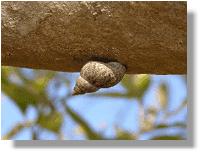 |
| Figure 8. The arboreal mangrove
snail Littorina |
Figure 8: Many different types of animals live in the mangroves
at Rowes Bay - some hide by burying in the sediments while others,
such as the arboreal snail (Littorina) shown here, live in
mangrove tree branches. The shells of these tree-dwelling snails are
very light in comparison to ground dwelling (benthic) snails making
it easier for them to carry their protective shell “home”
around with them when climbing. |
| ROCKY
SHORE |
|
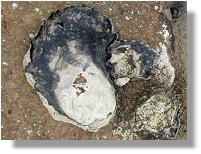 |
| Figure 9. Oysters Saccostrea
echinata |
Figure 9: Several different oysters can be found attached to
the rocks at Rowes Bay. Such oysters are bivalve molluscs (with two-shells)
that are able to cement one of their protective valves to hard substrates.
This means that oysters like the Saccostrea echinata shown
here are sessile and therefore unable to move around as adults.
 |
| Figure 10. The tiny but numerous
Nodilittorina snails |
Figure 10: Animals that feed on algae, such as the herbivorous
snail (Nodilittorina) seen clustered together here, are a cryptic
but very important part of the rocky shore habitat. Although tiny
(<10 mm) they are present in very large numbers and the rocky surfaces
high on the intertidal area would look very different (covered in
green algae) if these animals were not present. |
| ROCKY
RUBBLE HABITAT |
|
Figure 11a & b: Seahares like the Aplysia dactylomela seen
here are relatively large shell-less molluscs that are seasonally
common in tropical coastal areas. This species is well known for
is spectacular behaviour of releasing bright purple ink that functions
as a deterrent or a distraction to predators such as fish, crabs
or humans. Seahares play an important role in many coastal habitats
because of their habit of periodically occurring in large numbers
and their ability to consume large amounts of macroalgae, including
the toxic cyanobacterium Lyngbya.
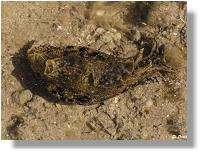 |
 |
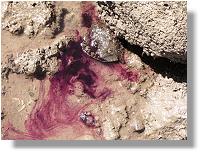 |
| Figure 11a. Seahare Aplysia
dactylomela |
|
Figure 11b. Seahare inking
when disturbed |
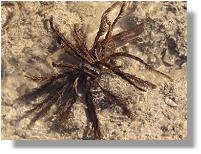 |
| Figure 12. Feather star |
Figure 12: The feather star shown here is a very primitive
member of the phylum Echinodermata and not often seen in intertidal
coastal environments. It is related to the starfish and sea urchins,
which are more commonly seen by reef visitors. This feather star is
nocturnal (active at night) and normally lives in deeper water offshore.
However, it is sometimes washed into intertidal areas like Rowes Bay
by storms and bad weather. |
| CREEK
& FINE MUD |
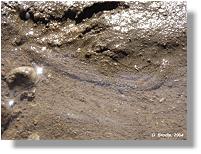 |
| Figure 13: The proboscis (feeding
organ) of an echiurian worm |
Figure 13: The fine mud around the creek bed provides a suitable
home for several different worm species. Although often unattractive,
worms play a vital role in aerating and mixing the fine sticky sediment
allowing a broader range of organisms to exploit the habitat’s
resources. Most of these worms are cryptic and live buried in the
fine sediment with only their soft feeding structures visible above
the substrate. One of these worm species is the echurian and with
careful observation its long translucent proboscis (feeding organ)
can be seen here laying over the surface of the sediment. |
| SANDY
FLATS |
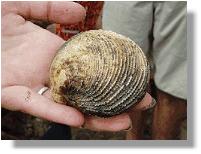 |
| Figure 14: Bivalve mollusc
Periglypta |
Figure 14: Many different bivalve molluscs can be found within
the Rowes Bay intertidal area. One of the largest ones (Periglyta
chemnitzi) is difficult to find alive because of its excellent
burrowing ability, however the hard shells left behind after it dies
clearly indicate its presence in the soft sandy and muddy habitats.
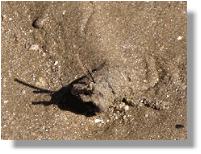 |
| Figure 15: Tube dwelling polychaete
worm Diapatra |
Figure 15: Diapatra is a relatively large polychaete
worm that makes its own flexible silky tube within the sandy flat
environment of Rowes Bay. However, only the very distinctive tip of
this tube can be seen above the surface of the substrate. Like many
burrowing animals Diapatra is very fussy about the type of
sediment it lives in. If the sediment composition changes too much
the next generation of animals will not survive in the same place. |
| OUTER
REEFAL AREA |
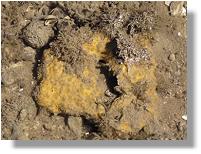 |
| Figure 16. Unknown sponge |
Figure 16: Many different species of sponges can be found in
the intertidal area at Rowes Bay. Although often colourful, like the
yellow sponge seen here, these colonial animals can be difficult to
identify. Sponges feed by filtering large volumes of seawater and
extracting the digestible material from it. The species found at Rowes
Bay cope surprisingly well with the turbid muddy conditions that surround
them.
 |
| Figure 17 : Nudibranch seaslug
Cuthona yamasui |
Figure 17: There are thousands of different types of shell-less
marine seaslugs (nudibranchs) found worldwide. The species shown here
was found among the rocky rubble of the outer reefal area at Rowes
Bay. Its scientific name is Cuthona yamasui and it was first
described from Japan in 1993. This specimen is about 45 mm long and
feeds on bryozoans (small colonial animals) also found in the same
habitat. Bryozoans, and the animals that prey on them, are very important
marine organisms because they are part of “fouling” communities
that initially cover human-made marine structures such as jetties
and boat hulls. Control of such fouling organisms is a very “hot”
topic in marine biology because it strongly relates to the economic
efficiency of our boats, ships and harbours. |
|